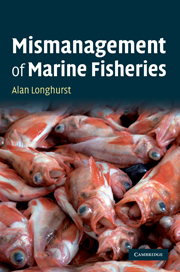Book contents
- Frontmatter
- Contents
- Preface
- 1 From certainty to doubt in fishery science
- 2 The ecological consequences of the exceptional fecundity of teleosts
- 3 Indeterminate growth, negative senescence and longevity
- 4 Marine ecosystems: their structure and simulation
- 5 The natural variability of fish populations and fisheries
- 6 Has sustainability in fishing ever been achieved?
- 7 What is the real state of global fish populations?
- 8 The mechanics of population collapse
- 9 Why don't some fish populations recover after depletion?
- 10 Is the response of the fishery science community appropriate?
- 11 Conclusion: sustainability can be achieved rarely and only under special conditions
- Index
8 - The mechanics of population collapse
Published online by Cambridge University Press: 05 July 2014
- Frontmatter
- Contents
- Preface
- 1 From certainty to doubt in fishery science
- 2 The ecological consequences of the exceptional fecundity of teleosts
- 3 Indeterminate growth, negative senescence and longevity
- 4 Marine ecosystems: their structure and simulation
- 5 The natural variability of fish populations and fisheries
- 6 Has sustainability in fishing ever been achieved?
- 7 What is the real state of global fish populations?
- 8 The mechanics of population collapse
- 9 Why don't some fish populations recover after depletion?
- 10 Is the response of the fishery science community appropriate?
- 11 Conclusion: sustainability can be achieved rarely and only under special conditions
- Index
Summary
‘The amount of uncertainty in an assessment is directly proportional to the amount of scientific rigor applied. The better you get at describing uncertainty, the worse you will be at providing useful advice.’
Peter Koeller, 2003The collapse of a fishery is usually interpreted as being the result of a simple negative balance between fishing mortality and the population growth of the target species: in short, as a result of ‘overfishing’. It is often suggested that this occurs because scientific management depends on inadequate models, or on incorrect assumptions concerning acceptable levels of mortality, with the consequence that permissible catch levels may be set too high. But this ignores some very important aspects of the environment in which management decisions are made. For a start, it ignores the simple ‘garbage in–garbage out’ effect due to incorrect or insufficient stock assessment data, and also ignores the likelihood that, even if the scientific advice is correct, it may be ignored or manipulated by the regulators.
It also ignores the simple fact that the dynamics of a fishery are very complex. Population collapses cannot necessarily be understood by reference to the performance of single-species analyses alone, even if these are the central subject matter of fishery science, which has concentrated too much of its attention on the relationship between fish population growth and fishing mortality and too little on the internal dynamics and stresses of the fishing industry. These are equally complex and – in many ways – more opaque and difficult to study, yet, by fair means and foul, the fishing industry does have a strong influence on the actual pattern and intensity of fishing that occurs at sea, and this may be quite different from what has been recommended by the scientists to the regulators.
- Type
- Chapter
- Information
- Mismanagement of Marine Fisheries , pp. 195 - 228Publisher: Cambridge University PressPrint publication year: 2010



